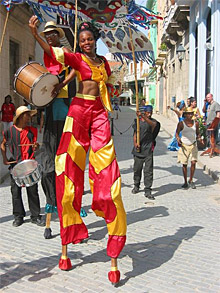 |
 |
 |
 Travel & Outdoors | The Cuba Connection | March 2005 Travel & Outdoors | The Cuba Connection | March 2005  
Havana Carnival Time!
 Rafael Lam - Granma International Rafael Lam - Granma International
 
| Carnival has always been a form of collective resistance against the culture of the elites.

|
Havana - The Havana carnival is now held in February and March instead of July and November. This year, the carnival will coincide with the 485th anniversary of the founding of the city.

There is evidence indicating that a carnival was held before 1585 in the newly-established town of Havana. This fiesta included profane elements from the Corpus Christi procession. There were carts, tarascas (monstrous dragon figures) and large puppets.

It is claimed that in 1760, people from Havana congratulated the general of the Army in person. After that, Lieutenant General Emilio Callejea Isasi, governor of the island, passed a public order law applicable to the entire island on April 23, 1870. In 1895 the first carnival was recorded.

Carnival celebrations abound in almost all Cuban provinces and towns, some being more traditional than others. For instance, the Santiago de Cuba carnival is similar to that of Salvador de Bahía in Brazil, where people dance on the streets as they follow the parade. In Havana, there are floats and comparsas (musical group), but the public does not participate.

In any case, with or without modifications, carnivals are the most animated fiestas in Cuba, where people participate in different ways. Hundreds of people from Havana’s neighborhoods and organizations join the comparsas, and rehearse throughout the year with great enthusiasm. Many of these comparsas and floats take part in the carnivals staged in villages and in the provinces.

This is a celebration of national identity that acts as a shield from meaningless foreign arts that have little to do with the country. Carnival has always been a form of collective resistance against the culture of the elites.

This is a spontaneous and earthy fiesta with conga played on home-made instruments, handcrafted in such way that they do not need amplification. This is a type of music to be listened to and felt, ecstatically and in a collective frenzy. Alejo Carpentier called it “traveling ballet.”

The most intense expression of the carnival is the comparsa, as the learned Fernando Ortiz remarked. The origin of comparsas has been the subject of widespread debate, just like almost all popular art forms. But, without a doubt, the comparsa’s nature has always been linked to enjoyment.

Carnival is an allegorical parade of lights and colors, high-pitched and magic sound. Music itself falls silent before the dancers’ frenzy and commotion. During carnival time, people dance deliriously and there is nothing in the world more important than joy. Everywhere there is an atmosphere of community, of art of the masses, the result of popular imagination.

There is no better way to discover the real essence of a people than when they are celebrating and dancing, in a perpetual state of joy. As is well known, Cubans are extremely fun-loving, and they can’t imagine life without music, dance and fiestas. Perhaps carnival has been most influential art in Cuban culture with its broad range of elements.

Many people celebrate carnivals, lavish fiestas that show human beings’ will to express their joy. Cuban carnivals are simpler today because of current economic restrictions. But fun relies more on someone’s mood than on luxury and glamour.

In my opinion, Cuban carnival has the richest rhythm in America, and it offers an opportunity to contemplate that percussion arsenal, so well preserved in Havana’s neighborhoods, which confers it its great power.

The carnival also offers us an opportunity to meet old friends and have fun with them. | 
 | |
 |



